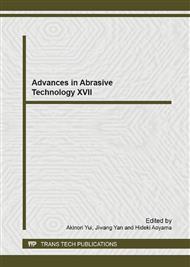p.500
p.509
p.515
p.520
p.526
p.532
p.539
p.544
p.549
Precision Shaping Experiment of Ceramic Ball Blank with Oscillating-Plate Lapping Method
Abstract:
An oscillating-plane lapping method, by which pre-sintered ceramic ball blanks are shaped before full sintering, was proposed to improve the precision of the ceramic ball blanks. For good sphercity and diameter consistency of ceramic ball blanks obtained after this shaping process, much less workmaterial is needed to be removed in the following lapping process of the full sintered ceramic ball blanks. Shaping experiments were carried out on a newly developed oscillating-plane lapping device. Results show that material removal rate of the pre-sintered Si3N4 ball blanks with nominal diameter Ø13mm reaches 0.92mm/h in average. The sphericity error is reduced from 0.07-0.196mm to 0.002-0.006mm, and the consistency error of diameter is reduced from 0.309 to 0.019mm after 45min's shaping. Compared with the processing time of the unshaped full-sintered blanks in the following lapping process, it takes just a half time for the shaped full-sintered blanks to be semi-finished in this study. It indicates that the oscillating-plane lapping is a promising high efficient method to improve the precision and consistency of the ceramic ball blanks, and the efficiency of the followed lapping process can be improved notably.
Info:
Periodical:
Pages:
526-531
Citation:
Online since:
September 2014
Authors:
Price:
Сopyright:
© 2014 Trans Tech Publications Ltd. All Rights Reserved
Share:
Citation:


